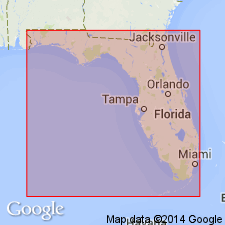
- Usage in publication:
-
- Choctawhatchee marl
- Modifications:
-
- Original reference
- Dominant lithology:
-
- Marl
- Clay
- AAPG geologic province:
-
- Mid-Gulf Coast basin
Summary:
Table opp. p. 50 and p. 114-122. Choctawhatchee marl. Greenish to light-gray sandy shell marl and greenish gray plastic sandy clay. Thickness is 30 to 50 feet. Rests unconformably on Alum Bluff group and is overlain by Pliocene beds. Is of marine origin. [Age is middle and late Miocene.]
[Named for exposures on Choctawhatchee River in Walton Co., western FL. Recognized in western FL and St. Johns Valley, FL.]
Source: US geologic names lexicon (USGS Bull. 896, p. 438).
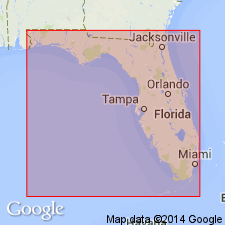
- Usage in publication:
-
- Choctawhatchee formation
- Modifications:
-
- Redefined
- Revised
- AAPG geologic province:
-
- Mid-Gulf Coast basin
Summary:
Name changed to Choctawhatchee formation because the marl beds that contain the characteristic fossils of the Choctawhatchee make up only a part of formation and are less persistent than the clay. Divided into (descending): (1) CANCELLARIA zone and (2) "aluminous clay," both upper Miocene; (3) ECPHORA zone, (4) ARCA zone, and (5) YOLDIA, all middle Miocene.
Source: US geologic names lexicon (USGS Bull. 896, p. 438).
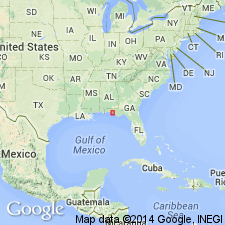
- Usage in publication:
-
- Choctawhatchee formation
- Modifications:
-
- Revised
- AAPG geologic province:
-
- Mid-Gulf Coast basin
Summary:
Pg. 264, 269, 269-272. Choctawhatchee formation. Term Permenters Farm beds proposed that lie above ARCA zone in Choctawhatchee formation. Beds have been assigned to overlying ECPHORA zone by earlier workers. Formation includes (ascending) YOLDIA zone, ARCA zone, Permenters Farm beds, ECPHORA zone, and CANCELLARIA zone. [Age is middle and late Miocene.]
Source: US geologic names lexicon (USGS Bull. 1200, p. 787-788).
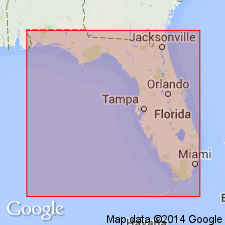
- Usage in publication:
-
- Choctawhatchee formation†
- Modifications:
-
- Abandoned
- AAPG geologic province:
-
- Mid-Gulf Coast basin
Cooke, C.W., 1945, Geology of Florida: Florida Geological Survey Bulletin, no. 29, 339 p.
Summary:
Pg. 168. †Choctawhatchee formation abandoned. YOLDIA and ARCA zones transferred to Shoal River formation; ECPHORA and CANCELLARIA zones classified as Duplin marl.
Source: US geologic names lexicon (USGS Bull. 1200, p. 787-788).
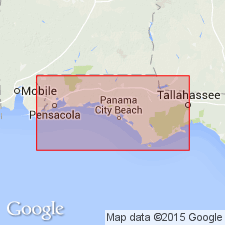
- Usage in publication:
-
- Choctawhatchee stage
- Modifications:
-
- [Reinstated]
- Revised
- AAPG geologic province:
-
- Mid-Gulf Coast basin
- South Georgia sedimentary province
Summary:
Pg. 16 (table 1), 18 (fig. 2), 27-36, fig. 3 facing p. 18. Choctawhatchee stage includes all Miocene sediments of post-Alum Bluff age in Florida Panhandle and their equivalents in Central and Western Gulf States. In Florida Panhandle, four biofacies, YOLDIA, ARCA, ECPHORA, and CANCELLARIA, are recognized. These biofacies considered faunizones within Choctawhatchee formation. Type exposure of formation designated as type exposures of stage. Term Permenters Farm beds dropped.
Source: US geologic names lexicon (USGS Bull. 1200, p. 787-788).
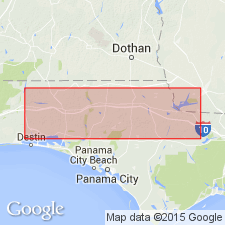
- Usage in publication:
-
- Choctawhatchee
- Modifications:
-
- Not used
- AAPG geologic province:
-
- Mid-Gulf Coast basin
Summary:
Alum Bluff Group referred to as undifferentiated in this report. Because formations assigned by previous workers were differentiated on the basis of micro- and macrofossil faunas and implied age, not lithology, and do not satisfy the requirements of the Code, they are not used by this author. Alum Bluff is described in several outcrops and includes sediments differentiated as Chipola, Shoal River, Oak Grove, Whites Creek, Choctawhatchee, Red Bay, and Yellow River by others. Outcrop 10, at Red Bay, Walton Co., was previously referred to as the Choctawhatchee, the middle unit of the Alum Bluff by Matson and Clapp (1909). This outcrop of undifferentiated Alum Bluff was also considered to be the type locality of the "short lived" Red Bay Formation of Choctawhatchee age by Puri and Vernon (1964).
Source: GNU records (USGS DDS-6; Reston GNULEX).
- Usage in publication:
-
- Choctawhatchee
- Modifications:
-
- Overview
- AAPG geologic province:
-
- Mid-Gulf Coast basin
GNU Staff, 1991, GNU Staff remark by R.C. Orndorff. Choctawhatchee.: U.S. Geological Survey Digital Data Series, DDS-6, 1 CD-ROM., release 3
Summary:
Although the Choctawhatchee has been abandoned, the name has still been used periodically when referring to early reports or early 20th Century fossil collections. Tom Gibson, USGS (personal commun.) suggests that the name is not in use anymore and has been split up into other formations: Shoal River Formation, Duplin Marl, Jackson Bluff Formation, and Chipola Formation.
Source: GNU records (USGS DDS-6; Reston GNULEX).
For more information, please contact Nancy Stamm, Geologic Names Committee Secretary.
Asterisk (*) indicates published by U.S. Geological Survey authors.
"No current usage" (†) implies that a name has been abandoned or has fallen into disuse. Former usage and, if known, replacement name given in parentheses ( ).
Slash (/) indicates name conflicts with nomenclatural guidelines (CSN, 1933; ACSN, 1961, 1970; NACSN, 1983, 2005, 2021). May be explained within brackets ([ ]).

